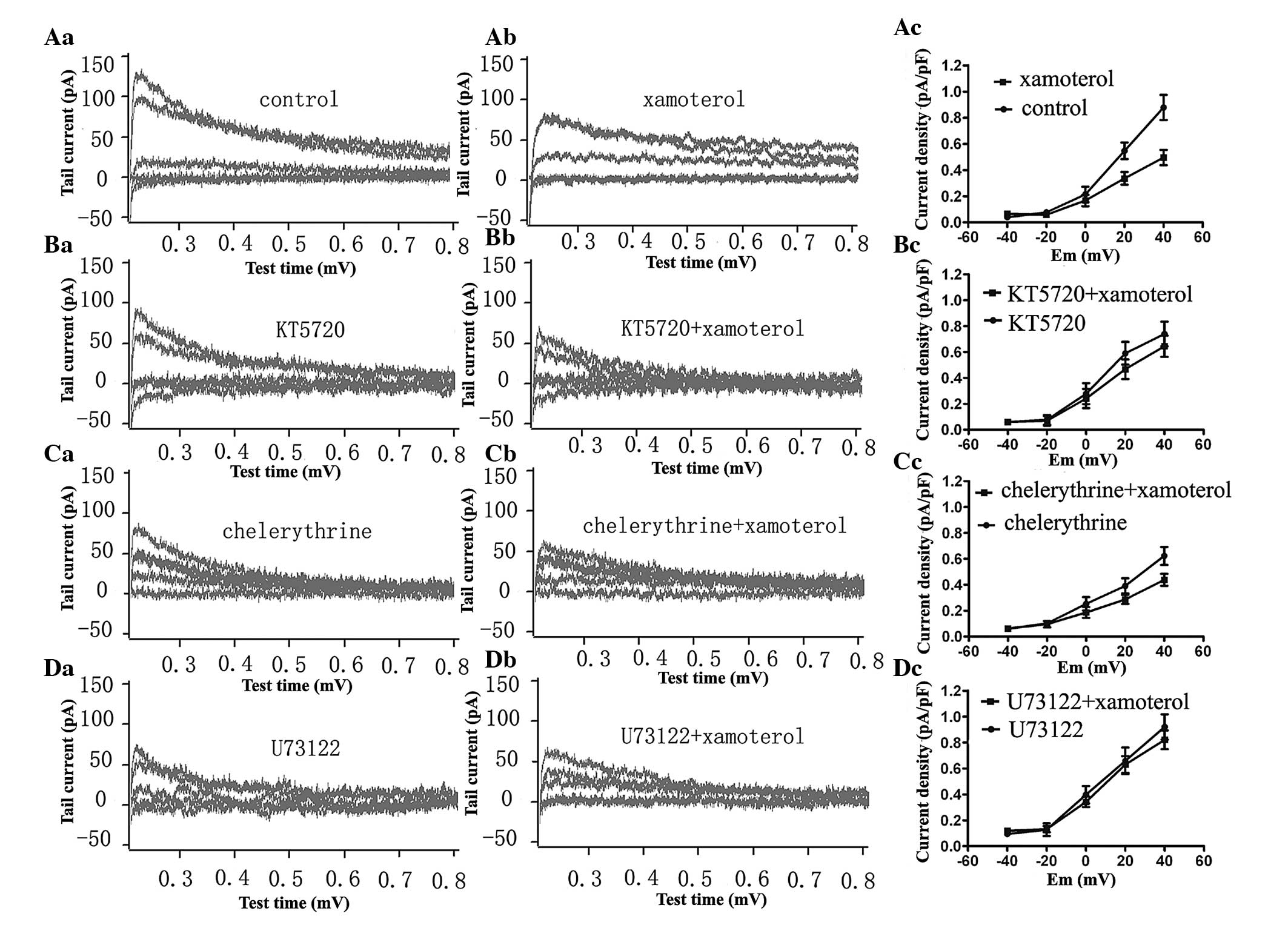|
1
|
Thomas D, Karle CA and Kiehn J: The
cardiac hERG/IKr potassium channel as pharmacological target:
structure, function, regulation, and clinical applications. Curr
Pharm Des. 12:2271–2283. 2006. View Article : Google Scholar : PubMed/NCBI
|
|
2
|
Charpentier F, Mérot J, Loussouarn G and
Baró I: Delayed rectifier K(+) currents and cardiac repolarization.
J Mol Cell Cardiol. 48:37–44. 2010.
|
|
3
|
Sanguinetti MC, Jiang C, Curran ME and
Keating MT: A mechanistic link between an inherited and an acquired
cardiac arrhythmia: HERG encodes the IKr potassium channel. Cell.
81:299–307. 1995. View Article : Google Scholar : PubMed/NCBI
|
|
4
|
Ficker E, Thomas D, Viswanathan PC, et al:
Novel characteristics of a misprocessed mutant HERG channel linked
to hereditary long QT syndrome. Am J Physiol Heart Circ Physiol.
279:H1748–H1756. 2000.PubMed/NCBI
|
|
5
|
Thomas D, Gut B, Wendt-Nordahl G and Kiehn
J: The antidepressant drug fluoxetine is an inhibitor of human
ether-a-go-go-related gene (HERG) potassium channels. J Pharmacol
Exp Ther. 300:543–548. 2002. View Article : Google Scholar : PubMed/NCBI
|
|
6
|
Roden DM: Human genomics and its impact on
arrhythmias. Trends Cardiovasc Med. 14:112–116. 2004. View Article : Google Scholar : PubMed/NCBI
|
|
7
|
Du L, Li M, You Q and Xia L: A novel
structure-based virtual screening model for the hERG channel
blockers. Biochem Biophys Res Commun. 355:889–894. 2007. View Article : Google Scholar : PubMed/NCBI
|
|
8
|
van Noord C, Sturkenboom MC, Straus SM,
Witteman JC and Stricker BH: Non-cardiovascular drugs that inhibit
hERG-encoded potassium channels and risk of sudden cardiac death.
Heart. 97:215–220. 2011.PubMed/NCBI
|
|
9
|
Vandenberg JI, Perry MD, Perrin MJ, Mann
SA and Hill AP: hERG K(+) channels: structure, function, and
clincal signifcance. Physiol Rev. 92:1393–1478. 2012.
|
|
10
|
Tutor AS, Delpón E, Caballero R, et al:
Association of 14-3-3 proteins to beta1-adrenergic receptors
modulates Kv11.1 K+ channel activity in recombinant
systems. Mol Biol Cell. 17:4666–4674. 2006. View Article : Google Scholar : PubMed/NCBI
|
|
11
|
Karle CA, Zitron E, Zhang W, Kathöfer S,
Schoels W and Kiehn J: Rapid component I(Kr) of the guinea-pig
cardiac delayed rectifier K(+) current is inhibited by
beta(1)-adrenoreceptor activation, via cAMP/protein kinase
A-dependent pathways. Cardiovasc Res. 53:355–62. 2002.
|
|
12
|
Thomas D, Kiehn J, Katus HA and Karle CA:
Adrenergic regulation of the rapid component of the cardiac delayed
rectifier potassium current, I(Kr), and the underlying hERG ion
channel. Basic Res Cardiol. 99:279–287. 2004. View Article : Google Scholar : PubMed/NCBI
|
|
13
|
Zankov DP, Yoshida H, Tsuji K, Toyoda F,
Ding WG, Matsuura H and Horie M: Adrenergic regulation of the rapid
component of delayed rectifier K+ current: implications for
arrhythmogenesis in LQT2 patients. Heart Rhythm. 6:1038–1046.
2009.
|
|
14
|
Chen J, Chen K, Sroubek J, Wu ZY, Thomas
D, Bian JS and McDonald TV: Post-transcriptional control of human
ether-a-go-go-related gene potassium channel protein by
alpha-adrenergic receptor stimulation. Mol Pharmacol. 78:186–197.
2010. View Article : Google Scholar
|
|
15
|
Wang S, Xu DJ, Cai JB, Huang YZ, Zou JG
and Cao KJ: Rapid component I(Kr) of cardiac delayed rectifier
potassium currents in guinea-pig is inhibited by
alpha(1)-adrenoreceptor activation via protein kinase A and protein
kinase C-dependent pathways. Eur J Pharmacol. 608:1–6. 2009.
View Article : Google Scholar
|
|
16
|
Brodde OE and Michel MC: Adrenergic and
muscarinic receptors in the human heart. Pharmacol Rev. 51:651–690.
1999.PubMed/NCBI
|
|
17
|
Olson EN: A decade of discoveries in
cardiac biology. Nat Med. 10:467–474. 2004. View Article : Google Scholar : PubMed/NCBI
|
|
18
|
Dong DL, Liu Y, Zhou YH, Song WH, Wang H
and Yang BF: Decreases of voltage-dependent K+ currents
densities in ventricular myocytes of guinea pigs by chronic oxidant
stress. Acta Pharmacol Sin. 25:751–755. 2004.PubMed/NCBI
|
|
19
|
Li Y, Sroubek J, Krishnan Y and McDonald
TV: A-kinase anchoring protein targeting of protein kinase A and
regulation of HERG channels. J Membr Biol. 223:107–116. 2008.
View Article : Google Scholar : PubMed/NCBI
|
|
20
|
Heath BM and Terrar DA: Protein kinase C
enhances the rapidly activating delayed rectifier potassium
current, IKr, through a reduction in C-type inactivation in
guinea-pig ventricular myocytes. J Physiol. 522:391–402. 2000.
View Article : Google Scholar : PubMed/NCBI
|
|
21
|
Cui J, Melman Y, Palma E, Fishman GI and
McDonald TV: Cyclic AMP regulates the HERG K(+) channel by dual
pathways. Curr Biol. 10:671–674. 2000.
|
|
22
|
Zankov DP, Yoshida H, Tsuji K, Toyoda F,
Ding WG, Matsuura H and Horie M: Adrenergic regulation of the rapid
component of delayed rectifier K+ current: implications
for arrhythmogenesis in LQT2 patients. Heart Rhythm. 6:1038–1046.
2009. View Article : Google Scholar : PubMed/NCBI
|
|
23
|
Kiehn J, Karle C, Thomas D, Yao X,
Brachmann J and Kübler W: HERG potassium channel activation is
shifted by phorbol esters via protein kinase A-dependent pathways.
J Biol Chem. 273:25285–25291. 1998. View Article : Google Scholar : PubMed/NCBI
|
|
24
|
Thomas D, Kiehn J, Katus HA and Karle CA:
Defective protein trafficking in hERG-associated hereditary long QT
syndrome (LQT2): molecular mechanisms and restoration of
intracellular protein processing. Cardiovasc Res. 60:235–241. 2003.
View Article : Google Scholar : PubMed/NCBI
|
|
25
|
Bian JS, Kagan A and McDonald TV:
Molecular analysis of PIP2 regulation of HERG and IKr. Am J Physiol
Heart Circ Physiol. 287:H2154–H2163. 2004. View Article : Google Scholar : PubMed/NCBI
|
|
26
|
Bian JS and McDonald TV:
Phosphatidylinositol 4,5-bisphosphate interactions with the HERG
K(+) channel. Pflugers Arch. 455:105–113. 2007.
|
|
27
|
Cockerill SL, Tobin AB, Torrecilla I,
Willars GB, Standen NB and Mitcheson JS: Modulation of hERG
potassium currents in HEK-293 cells by protein kinase C. Evidence
for direct phosphorylation of pore forming subunits. J Physiol.
581:479–493. 2007. View Article : Google Scholar : PubMed/NCBI
|














